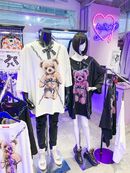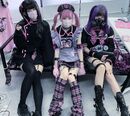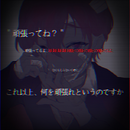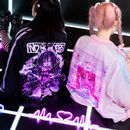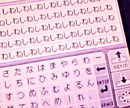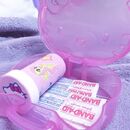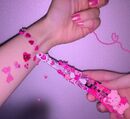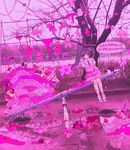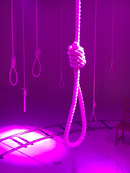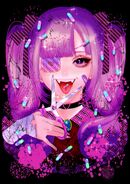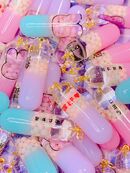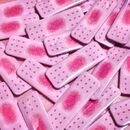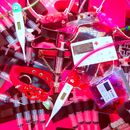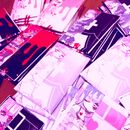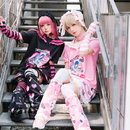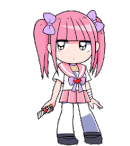Reason for Warning: This article discusses mental health issues. Keep in mind that this shouldn't be used as just a cutesy aesthetic.
Yami Kawaii (病みかわいい or やみかわ), directly translating into "sickly cute", is a Japanese aesthetic that was derived from Yume Kawaii with a stronger emphasis on dark themes and colors. As the term can also be used as an adjective, its interpretation can vary a lot depending on the context as a character being described as Yami Kawaii can simply refer to their personality being dark and cute without visually representing the aesthetic.
It is often confused with the Gurokawa aesthetic, which has a focus on cutified horror, but Yami Kawaii has more of shoujo spin to it with many anime-style illustrations involved, and is not bloody or gory.
History[]
The aesthetic first emerged among the members of Japan's mental health subculture "Menhera" during the 2000s, but didn't have an own name until 2015. The initial purpose of the aesthetic was to have a creative outlet to cope with mental health issues while also challenging the social stigma that judges a person's suffering by a bad appearance. However, with the increasing media awareness of Yami Kawaii there also came an over-commercialization that reduced it to simply medical motifs.
Visuals[]
Generally Yami Kawaii is kept in dark colors to match its negative world view. While pastel colors are also used, it's usually for the purpose of making important details stand out from the rest of the image. Morbid elements are often not noticeable at first glance within the overall cute imagery. There are many medical items, suicide and self harm tools, negative messages, vent art images, and traces of pink blood.
Fashion[]
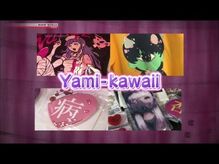
Genres of Kawaii Yami Kawaii
While there are many ways that Yami Kawaii can be integrated into fashion, the most common seem to be dark casual outfits featuring motifs with opposing elements, like cute animals with negative texts, in the form of prints. There are also many medical accessories such as Band-Aid hair clips, syringe necklaces, and pill bracelets due to the nature of the aesthetic.
Makeup is worn regardless of gender in Yami Kawaii in order to archive a sickly look by applying pink or red blush right under the eyes instead of the traditional use on the apple of the cheeks, and is often further exaggerated by enchanting the natural eye bag line. Lips are usually kept very simple but gradients are also very popular.
Media[]
Manga & Anime[]
- Ai no Donor
- Artiswitch
- Crazy Dark Rabbit (クレイジー闇うさぎ)
- Happy Sugar Life
- Kuuchuu Buranko
- Mahou Shoujo Site
- Mahou Shoujo Raising Project
- Menhera-chan
- Sayonara, Zetsubou-Sensei
- Suicide Girl
- Yuki Yuna is a Hero
Video Games[]
- Amane Switch
- Menhera Ensemble
- Menhera Fresia
- Needy Streamer Overload
- Omori
Music[]
Artists[]
Popular artists within Yami Kawaii include:
- CHICKwarp
- Fanatic
- Mio Yamazaki
- Misola de Edison
- R-Shitei
- Strawberry Painkiller
- Sylph emew
- Takayan
- Tuyu
- Yandoll
- Yukueshirezutsurezure
- Zenbu kimi no seida.
- Cy8er(BPM15Q)
- Candye♡Syrup
There's also many VOCALOID producers who are popular within the aesthetic's community because of the combination of depressing themes with the adorable voices of the characters in their songs, such as:
- Amu
- Daijoubu-P
- GogatsuP
- Hirose Aru
- Kairiki Bear
- Kikuo
- Mafumafu
- Menhera Hiyoko
- Pepoyo
- PinocchioP
- Surii
- Syudou
- Wowaka
- MARETU
Criticism[]
Bisuko Ezaki (Menhera-chan)[]
The spread of Yami Kawaii is often credited to have been helped by the character and manga series "Menhera-chan" in particular. It was first created in 2013 by the artist Bisuko Ezaki as a form of vent art character during his university entrance exams, but gained an unexpected amount of attention that led to an expansion into an own manga series as of 2014.
Because of the background of its creation, the story of Menhera-chan is not suitable for everyone because of its heavy emphasis on themes of self-harm, and might even be misunderstood as romanticizing such a topic as the main cast transforms into magical girls by the means of slitting their wrists. With the increasing awareness of the series, there also appeared a massive influx of people who solely use the art of the characters for the purpose of glorifying self-harm. On Twitter in particular, it has become commonplace for the official Menhera-chan account to share fan content from accounts of such people, potentially exposing strangers to graphic content.
While the series inspired many other people to use art as as a creative outlet to break the silence regarding their suffering, there also have been many critical voices claiming the increasing popularity went over Bisuko Ezaki's head, fueled by his attempt to register Yami Kawaii as his trademark in 2017 [1] as well as an increase in general drama and problematic remarks from the artist.[2]
Resources[]
External links to help get a better understanding of this aesthetic.
Communities[]
Vendors[]
- ACDC RAG
- Acro Tokyo
- Amilige
- AnkoROCK
- Atelier M.U (Menhera-chan Official Store)
- Backside of Tokyo
- Funky Fruit
- Jamie Ank
- KRY Clothing
- Listen Flavor
- Sex Pot Revenge
Playlists[]
- Sickly Cute ☆ Yami-Kawaii by orlok
- yami Kawaii | menhera🏩💉 by yooji
- °•💖 🎀 yami kawaii 🔪🐰•° by ❤︎︎
- sick cute / yami kawaii by Stela
- loser god♡ by amita
- I wanna die, do you? by menhera princess
Pinterest Boards[]
- メンヘラ 💉 menhera by shinitamihime
- Yami Kawaii Everything~♡ by 𝙸𝚌𝚊𝚛𝚞𝚜 シ
- Cute! (menhera & yami kawaii) by Corndog

